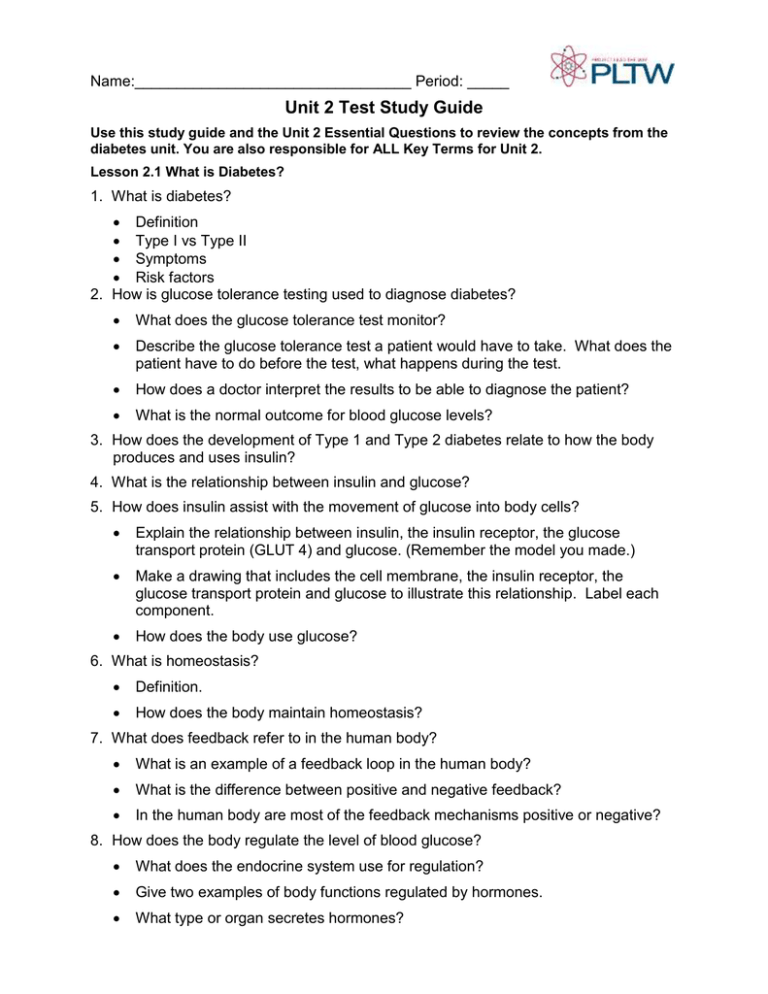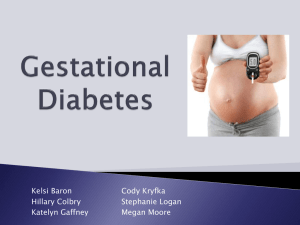Unit 2 Test Study Guide
advertisement

Name:_________________________________ Period: _____ Unit 2 Test Study Guide Use this study guide and the Unit 2 Essential Questions to review the concepts from the diabetes unit. You are also responsible for ALL Key Terms for Unit 2. Lesson 2.1 What is Diabetes? 1. What is diabetes? Definition Type I vs Type II Symptoms Risk factors 2. How is glucose tolerance testing used to diagnose diabetes? What does the glucose tolerance test monitor? Describe the glucose tolerance test a patient would have to take. What does the patient have to do before the test, what happens during the test. How does a doctor interpret the results to be able to diagnose the patient? What is the normal outcome for blood glucose levels? 3. How does the development of Type 1 and Type 2 diabetes relate to how the body produces and uses insulin? 4. What is the relationship between insulin and glucose? 5. How does insulin assist with the movement of glucose into body cells? Explain the relationship between insulin, the insulin receptor, the glucose transport protein (GLUT 4) and glucose. (Remember the model you made.) Make a drawing that includes the cell membrane, the insulin receptor, the glucose transport protein and glucose to illustrate this relationship. Label each component. How does the body use glucose? 6. What is homeostasis? Definition. How does the body maintain homeostasis? 7. What does feedback refer to in the human body? What is an example of a feedback loop in the human body? What is the difference between positive and negative feedback? In the human body are most of the feedback mechanisms positive or negative? 8. How does the body regulate the level of blood glucose? What does the endocrine system use for regulation? Give two examples of body functions regulated by hormones. What type or organ secretes hormones? Is blood sugar regulation positive or negative feedback? Explain how it is possible that a problem with hormones and feedback led to Anna Garcia’s untimely death. Lesson 2.2 The Science of Food 1. What are the main nutrients found in food? What role does each of the main nutrients play in the body? 2. How can carbohydrates, lipids, and proteins be detected in foods? What is an indicator? What was the purpose of testing distilled water with each indicator? What types of changes occur in an indicator to show the presence of a particular compound? The change in the indicator is due to what? What indicator is used for each of the main macromolecules needed in the body? Include carbohydrates (simple sugars and starches), lipids and proteins. 3. What types of foods supply sugar, starch, proteins and lipids? 4. How can food labels be used to evaluate dietary choices? 5. What role do basic nutrients play in the function of the human body? 6. What are basic recommendations for a diabetic diet? 7. What are the main structural components of carbohydrates, proteins and lipids? Why are these molecules called macromolecules? What is a monomer? What is a polymer? Which macromolecules are polymers? What are considered the unifying features of lipids? What is the usual ratio of carbon, oxygen and hydrogen in a carbohydrate molecule? What is a monosaccharide? Give two examples. What is a disaccharide? Give two examples. 8. What is dehydration synthesis and hydrolysis? 9. How do dehydration synthesis and hydrolysis relate to harnessing energy from food? Explain the relationship between chemical bonds and energy in the body. 10. How is the amount of energy in a food determined? Review calculations used in the lab. How did you calculate the amount of water in the can? How did you calculate the change in temperature of the water? What is the formula used to calculate the energy gained by the water? (Why does it include the specific heat of water?) Lesson 2.3 Life with Diabetes 1. What are several ways the life of someone with diabetes is impacted by the disorder? 2. How do the terms hyperglycemia and hypoglycemia relate to diabetes? Define hyperglycemia. Define hypoglycemia. Relate each of these terms to blood sugar levels. 3. What might happen to cells that are exposed to high concentrations of sugar? Define osmosis. Describe what would happen to a cell in your body if blood sugar levels were very high in the bloodstream. 4. How do Type I and Type II diabetes differ? Explain what goes wrong with the insulin or insulin receptor for each case. How are the treatments different? How are lifestyle changes different? 5. What are the current treatments for Type I and Type II diabetes? Why are there different types of treatments for the different types of diabetics? List treatments for both types of diabetes and indicate which type of diabetic would use each treatment. 6. What is the importance of checking blood sugar levels for a diabetic? 7. How can an insulin pump help a diabetic? 8. What are potential short and long term complications of diabetes? 9. What innovations are available to help diabetics manage and treat their disease?








